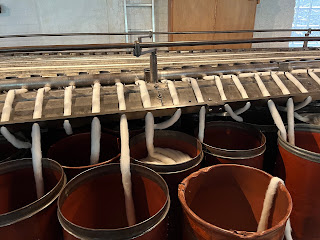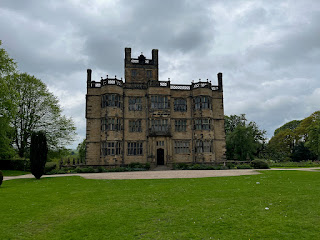This evening finds us in the fictional town of Darrowby
nestled in our comfy room: The Herriot Suite.
If you are at all familiar with the Masterpiece Theater Series, "All Creatures Great and Small", then the name and place should certainly ring a bell.
The real name of this town is Grassington, and it is a quaint village in the lower edge of the Yorkshire Dales. Our B&B is on the top floor of the fictional Drover's Inn featured in the series,
and it looks over the square, which is, surprisingly, very quiet tonight.
Certainly a lovely venue to take in the sites of this area.
We began our day at Quarrybank, a National Trust site that is far different from what we've visited so far on this trip. The site is a cotton mill, located in a gorge, that uses the local river source to power a water wheel that, in turn, was used to operate the mill. And at the time, it was the largest such mill in the country.
Included on the site is a small kitchen garden,

as well as a beautiful walking garden along one of the banks of the river.
Many of the rhododendrons and other plants that adorn the gardens were planted in the 1860's by Samuel's heir, Robert.
In brief, an Irish industrialist by the name of Samuel Greg had the foresight to build a cotton mill in 1784, along the River Bollin.
Within short time, he built his Georgian house right next to the mill so that he and his wife, Hannah, could enjoy the benefits of living in the country rather than in the city of Manchester.
He built a home for his wife and family right next to the mill so he was on site, and his wife was happy to be living in the country rather than in the dirt and grime of the city.

The interior of the house was charming and included portraits of the couple in their older years.

Samuel, being an Irishman, was a bit of a rebel of the day, and he chose to hang a portrait of George Washington over his fireplace.

That would certainly have caused a bit of a ruckus in the early 1800's!
What I particularly loved about the house is how, once again, the trust has presented information in a unique way that captures the viewer's attention. Instead of plates telling a bit of the story, this time it was the napkins.




Now, just how clever is that?
Samuel knew that in order to have a successful business that he needed to have happy and health workers, so he built garden houses for them, setting them in a small village, complete with a shop, near the factory. The village still exists to this day.
We learned that this mill, like others at the time, had 40% of its workhouse as children, ages 9 to 21. They were either orphaned or paupered, and they were brought to Quarrybank from other workhouses, mostly in the large cities.
But there was a huge difference in the living conditions for these children at Quarrybank in comparison with where they had come. 90 children were housed in the Apprentice House.
Samuel had hired a physician to be on site, to be sure that every child was kept healthy. He also insisted that they be fed hearty meals and the large bedrooms were set up with relatively roomy beds for the worker children to share. Samuel's wife insisted that the girls be taught lessons in addition to the boys, opening opportunities that the girls would have lacked elsewhere.
In reality, their lives were hard, working 12 hour days, then coming back to the apprentice house to chores, like gardening for the boys, and sewing for the girls, late in the day. And their working conditions were rough with cotton lint filling their lungs, not to mention the dangerous equipment that they were exposed to daily.
But in comparison to the life in the city workhouse, Quarrybank was considered to be extremely comfortable.
We toured the Apprentice House under the direction of an extremely entertaining guide who introduced us to the life that the children would have lived daily.
The wooden cups and bowls on the shelves are reminiscent of the scene in Oliver Twist where he asks if he can have some more porridge.

We were told stories of particular boys and girls who had been brought to the mill to work from other workhouses: their names, where they came from, as well as particular details that had all been found in the records uncovered in the archives.

Once again, a simple prop brought a glimpse into the life of these children so many years ago.
It certainly was an eye opening experience for us, and our guide deserved applause for his enthusiastic approach to grab our attention.
From here, we headed to the mill where we could walk through and examine the machinery.
What is extremely interesting is that the National Trust employees here continue to make cotton threads and fabric on this machinery, which they sell in the gift shop on site. So, we were given first hand exposure to just how the machines operate and the process from getting the cotton, to stretching rolling, and finally, making the thread.
It certainly was quite an informative tour!
From here we headed north of Manchester to another trust site, the Elizabethan Mansion, Gawthorpe hall.
It was originally a pele tower, built by the Shutleworth family in the 14th century to defend against innovation by the Scots. The house was then expanded around this tower, being completed during the early Elizabethan era.
What is truly amazing about this house is that it still has the original floors, ceilings and wall panelling from the 1600's when it was completed.
It also included an entertainment room that had a minstrel landing for performing musicians when it was fashionable to have performances in house. That's certainly the first time we've seen something like that!
And this bed dates back to the mid 1600's as well.
Rachel Kay Shutterworth made the embroidered bed coverings herself sometime in the early 1900's.
They took 10 years to complete, and it's not difficult to see why.
Peeking out the back window, we were treated to this lovely view of the back garden.
The guides in this landmark were delightful and we had a great time hearing their stories regarding the house. Honestly, the people who choose to volunteer for these sites all have such enthusiasm in sharing the stories. It brings a whole different light to the experience.
We were once again blessed with beautiful weather, and we didn't see a raindrop until we landed in Grassington.
Now, to explore the Yorkshire Dales.
I'll keep you posted!












































